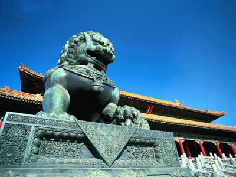
The lion is known as the king of the animals. The first lion was presented to China during the Eastern Han Dynasty(AD25-220) by a king from the western regions.
The earliest stone lion was discovered in an Eastern Han Dynasty tomb in Ya'an,Sichuan Province. The stone lions in Liang Chao's Tomb in Jurong County,Jiangsu Province, are 1,400 years old. Those in the Tangshun Tomb in Shengyang City,Shaanxi Province, were built by the Tang Empress,Wu Zetian, for her mother. They are the most representative of all existing stone lions. During theMing Dynasty(1368-1644) stone lions were placed in front of palaces, government buildings, temples and even some rich family mansions to display power. Later, stone lion designs were carved as decorations on important architectural features, such as door lintels and eaves.Beijingis now home tomany stone lions made during the Ming andQingdynasties. These lions do not seem powerful and wild, but rather kind and gentle. On the well-known Lugou Bridge built during the Jin Dynasty (1115-1234), there are 140 engraved stone columns on each side, each bearing a lively stone lion on top, with nine small stone lions hidden under the big lion. While it is difficult to count all of the stone lions on Lugou Bridge accurately with the naked eye, in 1961, archeologists calculated there are 485 stone lions altogether.

Juzhou City in Cangzhou,Hebei Province, is also known as the Iron Lion City. It boasts the largest iron lion in China. At 6.1 meters long, 5.48 meters high and 3.15 meters wide, it is made of hundreds of 30- to 50-cm-sized iron cubes weighing about 40 tons. On the right side of the lion's neck and on its teeth are characters indicating the time the lion was cast. It appears strong and bold, with its head rising to face the north, its mouth open, its eyes glaring angrily, and its four legs spread apart, as if it had just stopped in its tracks. Cast on its stomach are the Diamond Sutra and the county chronicle of Cangzhou. The lion is the largest cast animal in early Chinese history and is of great value for researching ancient Chinese metallurgy, sculpture and Buddhist history.

Among the Chinese, the lion has become a symbol of bravery, power and good luck. Performance art also incorporates the lion to convey these sentiments. Folk artists have created the lion dance where the lion appears lovely yet naughty, temporarily shedding his stature as king of the jungle. The lion was not used exclusively by royal families in the imperial arts as was the case with the dragon and phoenix. Lion statues are very popular among the people and can often be guarding the front gates of ordinary family homes.
(Source: chinaculture.org)










